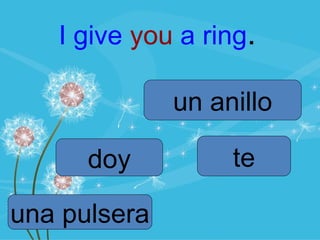Module 5 indirect objects (i.o.)
- 1. dar / comprar / traer I.O. , I.O. ItŌĆÖs off to work we goŌĆ”
- 2. Indirect Object Pronouns ŌĆó Indirect object pronouns tell to whom the action is being done . ŌĆó Answers the questions ŌĆ£to whomŌĆØ or ŌĆ£for whom.ŌĆØ ŌĆó Ex. I bring flowers to my mom. (To whom am I bringing flowers? My mom! Mom is the indirect object!) ŌĆó The shirt is for my dad. (For whom is the shirt? My dad! Dad is the indirect Object!)
- 3. Indirect Object Pronouns me (to or for me) nos (to or for us) te (to or for you) os (to or for you all) le (to or for him, les (to or for them, her, it) you all)
- 4. Placement of Indirect Object Pronoun ŌĆó Indirect Object Pronouns, me, te, le, nos, os, and les are placed either before a conjugated verb or attached to the end of an infinitive. Examples: ŌĆó I am giving the flowers to you. ŌĆó Te doy las flores ŌĆó I am going to give the flowers to her. ŌĆó Voy a darle las flores.
- 5. ┬ĪVamos a Practicar! LetŌĆÖs practice!
- 6. He gives me the purse. me la bolsa da le la olla dan
- 7. He gives me the purse. me la bolsa da le la olla dan
- 8. He gives me the purse. me la bolsa da la olla dan
- 9. He gives me the purse. me la bolsa da la olla dan
- 10. He gives me the purse. me la bolsa da la olla
- 11. He gives me the purse. me la bolsa da la olla
- 12. He gives me the purse. me la bolsa da
- 13. He gives me the purse. Me da la bolsa.
- 14. I buy you a belt. me una cartera compras te un cintur├│n compro
- 15. I buy you a belt. me una cartera compras te un cintur├│n compro
- 16. I buy you a belt. me una cartera te un cintur├│n compro
- 17. I buy you a belt. una cartera te un cintur├│n compro
- 18. I buy you a belt. una cartera te un cintur├│n compro
- 19. I buy you a belt. te un cintur├│n compro
- 20. I buy you a belt. Te compro un cintur├│n.
- 21. We buy them a pot. nos compramos les compran un plato una olla
- 22. We buy them a pot. nos compramos les compran un plato una olla
- 23. We buy them a pot. compramos les compran un plato una olla
- 24. We buy them a pot. compramos les compran un plato una olla
- 25. We buy them a pot. compramos les un plato una olla
- 26. We buy them a pot. compramos les un plato una olla
- 27. We buy them a pot. compramos les una olla
- 28. We buy them a pot. Les compramos una olla.
- 29. She gives me the money. das el dinero me le la comida da
- 30. She gives me the money. das el dinero me le la comida da
- 31. She gives me the money. el dinero me le la comida da
- 32. She gives me the money. el dinero me le la comida da
- 33. She gives me the money. el dinero me la comida da
- 34. She gives me the money. el dinero me la comida da
- 35. She gives me the money. el dinero me da
- 36. She gives me the money. Me da el dinero.
- 37. They give us the present. nos el regalo dan les la regla damos
- 38. They give us the present. nos el regalo dan les la regla damos
- 39. They give us the present. nos el regalo dan la regla damos
- 40. They give us the present. nos el regalo dan la regla damos
- 41. They give us the present. nos el regalo dan la regla
- 42. They give us the present. nos el regalo dan la regla
- 43. They give us the present. nos el regalo dan
- 44. They give us the present. Nos dan el regalo.
- 45. I give you a ring. me un anillo doy te una pulsera das
- 46. I give you a ring. me un anillo doy te una pulsera das
- 47. I give you a ring. me un anillo doy te una pulsera
- 48. I give you a ring. me un anillo doy te una pulsera
- 49. I give you a ring. un anillo doy te una pulsera
- 50. I give you a ring. un anillo doy te una pulsera
- 51. I give you a ring. un anillo doy te
- 52. I give you a ring. Te doy un anillo.
- 53. He brings them dinner. les el dinero trae le la cena traen
- 54. He brings them dinner. les el dinero trae le la cena traen
- 55. He brings them dinner. les el dinero trae le la cena
- 56. He brings them dinner. les el dinero trae la cena
- 57. He brings them dinner. les trae la cena
- 58. He brings them dinner. Les trae la cena.
- 59. I bring you a necklace. me traes traigo te un collar unos aretes
- 60. I bring you a necklace. me traes traigo te un collar unos aretes
- 61. I bring you a necklace. traes traigo te un collar unos aretes
- 62. I bring you a necklace. traes traigo te un collar unos aretes
- 63. I bring you a necklace. traigo te un collar unos aretes
- 64. I bring you a necklace. traigo te un collar unos aretes
- 65. I bring you a necklace. traigo te un collar
- 66. I bring you a necklace. Te traigo un collar.
- 67. We give you a bracelet. Te damos una pulsera.
- 68. I give him a watch. Le doy un reloj.
- 69. They give us the jewelry. Nos dan las joyas.
- 70. I give you the belt. Te doy el cintur├│n.
- 71. She give me the compact disc. Me da el disco compacto.
- 72. FIN.







































































